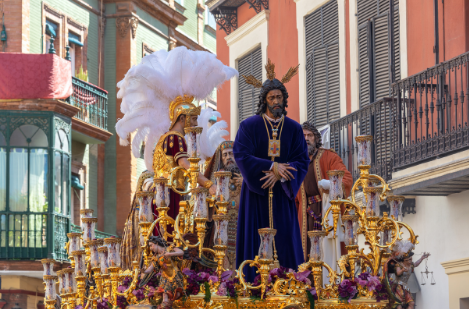‘Semana Santa’ in Alicante
Holy Week or Easter in 2022 runs from April 14
Here you have several ideas and possible plans to carry out and live Easter like an Alicantino! Why not try one of the typical local villages to see this spectacle?
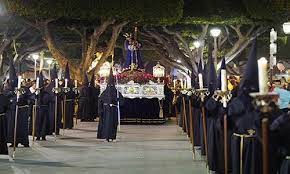
Almoradí:
Puedes visitar la procesión, mezcla de fervor, arte y tradición, que se viene celebrando desde finales del siglo XVIII. Las primeras cofradías en procesión por las calles de Almoradí fueron: El Santo Sepulcro, San Juan de la Palma, La Virgen Dolorosa, Jesús Nazareno, La Samaritana, La Virgen del Rosario y el Cristo de las Campanas.
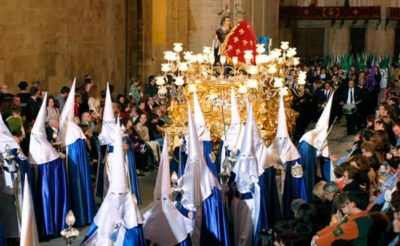
Orihuela:
Su procesión, es una de las expresiones religioso-culturales más destacas de España, representa otro atractivo cultural de la ciudad junto a su casco histórico declarado Conjunto Histórico-artístico y Monumental. Procesión General del viernes santo una de las más grandes de España al recoger diez cofradías y más de 8000 nazarenos, 1200 músicos, dos centurias romanas, y una centuria de Guardia Pretoriana. De especial singularidad es la procesión del Silencio, que se celebra en Jueves Santo desde la Real y Majestuosa Iglesia de Santiago de Orihuela donde es posible escuchar el sobrecogedor Canto de la Pasión.
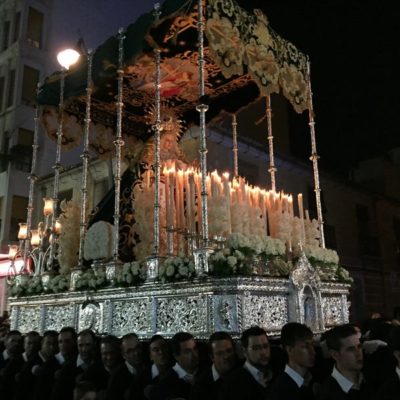
Torrevieja:
Su procesión ha sido declarada de Interés Turístico por la Generalitat Valenciana, y nació en el año 1981, sin embargo, su origen en la ciudad data del Siglo XIX. Cuenta con un total de 14 cofradías, esta Semana Santa tiene su propia idiosincrasia, cuenta con un gran patrimonio artístico compuesto por tronos, imaginería, orfebrería bordados, etc. Este evento anual es una muestra de cómo se integra el cosmopolitismo de la ciudad de Torrevieja, con cofrades y costaleros de diversas nacionalidades que hacen de esta celebración religiosa un evento muy singular, que no hay que perderse.
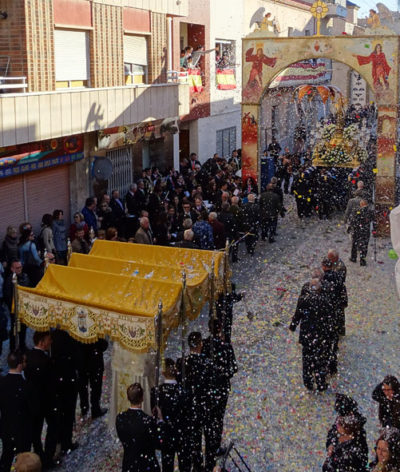
Rafal:
Mención especial a lo que hoy sin duda es emblema y signo de identidad de la Semana Santa rafaleña la popular “Graná“. Posiblemente su origen sea la procesión de las aleluyas que se celebran en otros pueblos para conmemorar la resurrección de Jesucristo, pero en esta localidad adquiere unos tintes particulares que la hacen no tener igual.
It was “Tía Corra” who had the idea of completing Passion Week with an act that would symbolize the power of the resurrection. Thus, and perhaps under the influence of what was done in other places, he ordered the construction of a papier-mâché “Graná” that contained colored pieces of paper, flower petals and even white doves inside.
Suspended from an arch, also built for this purpose and placed in the center of Calle Mayor, behind the church, the “Graná” would be opened and its fruits released at dawn on Sunday when the disconsolate mother, the Virgen del Rosario covered with black cloak and escorted by women of the town, saw her resurrected son, the Blessed under a canopy and accompanied by men.
La Gastronomía
Gastronomy is always very important on our Coast, but these days much more.



The Queen of the party “La Mona”.
The mona de Pascua is a typical food of the Spanish confectionery. Today you can find slight variations practically throughout the country. It is an Easter sweet that symbolizes that Lent and its abstinence are over.
You can find them these days in any traditional bakery.
The name “mona” comes from the munna, an Arabic term that means “provision of the mouth”, a gift that the Muslims gave to their lords. It is believed that the origin of the Monas de Pascua dates back to the 18th century.
At that time the tradition indicated that the grandfather or godfather should give the child a cake made with the same number of hard-boiled eggs as his age, the limit being twelve years.
However, it was not until the 19th century that chocolate monas began to replace hard-boiled eggs and were decorated with drawings and figures to celebrate Holy Week.
It is treason that on Easter Monday, called by many “the day of the mona”, families or groups of friends gather to eat the mona together somewhere.



